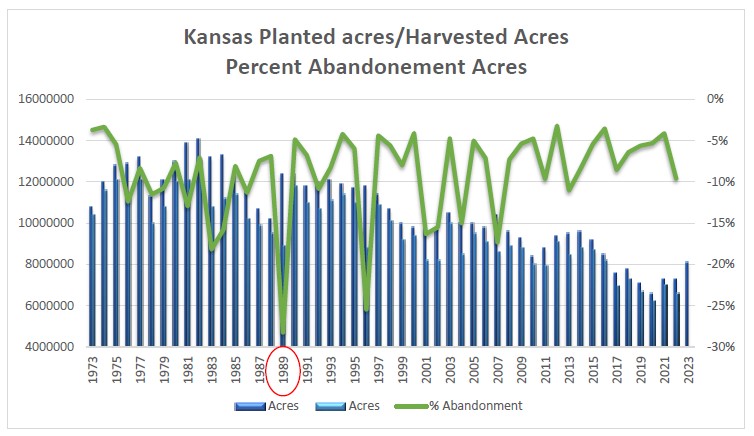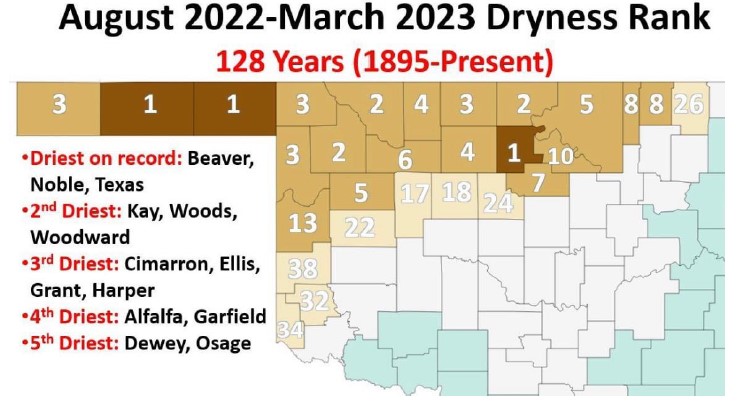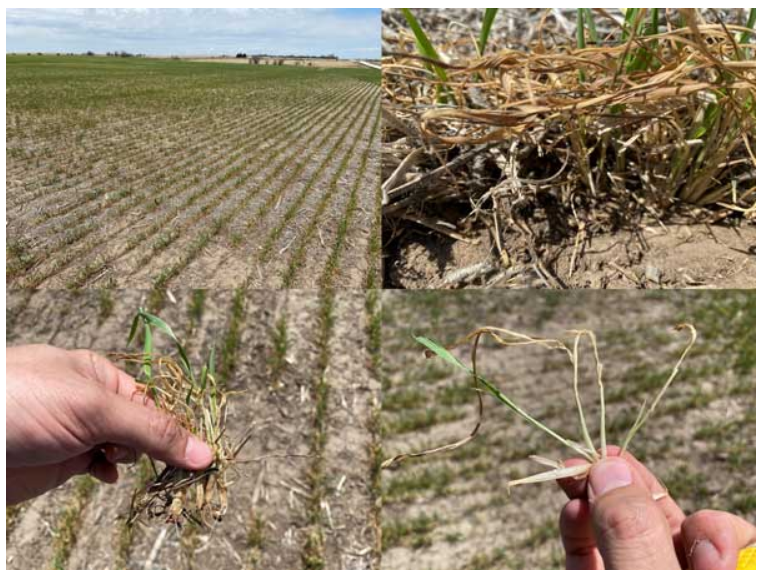The impact of drought in the Central and Southern U.S. Plains is the dominant topic of conversation about the 2023/24 hard red winter (HRW) crop. Industry participants agree there will be a lot of HRW fields abandoned before harvest from Texas to South Dakota. Rain expected this week is a hopeful sign but likely comes too late to provide extensive recovery.
Following are the latest perspectives on the now two year long drought from state wheat commission executives and media covering the market.
In his April 21 weekly report, Kansas Wheat Chief Executive Officer Justin Gilpin compared past drought year abandonment, specifically in 1989, to 2023. That year unharvested planted acres hit 28.2% following drought conditions that Gilpin and others said are very similar to the current situation.

A Crazy, Common Theme
“What is crazy in reading through high abandonment years, there is a common theme,” Gilpin said, “poor conditions through March into April…then, heavy rains began in May through June impacting harvest, but too late to help the western Kansas wheat crop.”
USDA’s April 24 crop conditions report echoed Gilpin’s comparison. It rated 26% of U.S. winter wheat in good to excellent condition, the lowest for this time of year since 1989. Reuters also noted “wheat in portions of central Kansas may have suffered damage from cold temperatures over the April 22-23 weekend. It is important to recognize that USDA’s winter wheat report includes the 2023 soft red winter (SRW) and soft white (SW) winter crops that are generally in much better condition.
In a call with state wheat commission representatives April 20, Darby Campsey with the Texas Wheat Producers Board reported that 30% of the state is in exceptional to extreme drought. In the Texas Panhandle, “much of the dryland wheat has failed.” Only 16% of Texas wheat is in good to excellent condition, mainly in the “black soil” region where mainly SRW is grown.
Dry as Death Valley
“In those regions that are in exceptional and extreme drought, you can certainly see why things are not favorable in northwest Oklahoma and the panhandle regions where we have the majority of our top wheat producing counties,” said Oklahoma Wheat Executive Director Mike Schulte.
There has been less than 0.8 cm of rain in that area of Oklahoma the last 220 days. Mark Hodges of Plains Grains noted that the Oklahoma Panhandle has received less moisture than Death Valley, California, the past 12 months.
“I don’t know that the rest of the world is taking into account how bad it is in the Southern Plains,” Schulte said in an interview with Oklahoma Farm Report. “I am hoping at some point in time the market is going to react to that.”

Colorado, Nebraska and South Dakota
Southeastern Colorado is also within the exceptional, long-term drought area. HRW and hard white (HW) wheat grown in northeastern Colorado has fared better with more rain and snow, but “needs more rain in May” to get closer to its yield potential. The state commission there reported that while 23% of wheat is in good to excellent conditions, 38% is rated poor to very poor.
Sub-soil moisture in the western and panhandle regions of Nebraska remains low with HRW and HW wheat in similar condition as in Colorado. Fields are “patchy” with 40% rated poor to very poor.
Abandonment of HRW in South Dakota is also a concern reported South Dakota Wheat Commission Executive Director Reid Christopherson. He said it was so dry last fall a significant portion of seeded fields did not emerge. After receiving more moisture over the winter, South Dakota HRW is now emerging, but if stands are not good, farmers may make crop insurance claims and replant to corn, Christopherson said.
Rain Too Late for Wheat
Returning to Justin Gilpin’s note that past drought years have seen rain coming too late for wheat crops, sure enough widespread rain was in the forecast for the Central and Southern Plains the week of April 24 “and could be substantial in some areas,” according to a weather brief by DTN Meteorologist Jon Baranick. “That will help to reduce the impact of the drought but will not make much of a dent in it. Additional showers could be possible late this week with another system. Wheat may not benefit from the rain too much due to poor conditions, but the increased soil moisture would favor corn [sorghum] and soybean planting.”
Farmers facing the difficult situation of losing a crop to drought that they worked hard to produce and the uncertainty of its impact on their family’s livelihood, have only the perspective of the generations before them to rely on.
“The key to remember here is that droughts are cyclical,” wrote columnist Brandon Case in the Pratt (KS) Tribune recently. “The land of Kansas has suffered from droughts long before it became a state and it will continue to experience droughts in the future. No one knows how long the current one will last and about the only thing any of us can do is pray for rain.”


